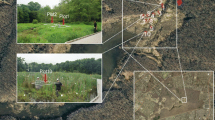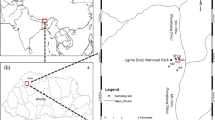Abstract
Wetland plant community composition and pattern are regulated by a host of abiotic/environmental gradients and biotic factors. We used multivariate analyses to classify wetland plant communities and determine the relation of hydrologic, edaphic, and geochemical gradients on community composition and spatial distribution among 18 vegetation, hydrology, and soil sampling points in Abe Run, a botanically unique poor fen in northeastern West Virginia. We also examined the interactions of disturbance with the physical environment and species composition. A total of 179 vascular plant species were identified from sample plots. Vegetative composition and structure, dominant soil texture, and hydrology lacked the distinct concentric zonation of northern peatlands; instead, all were patchy and varied considerably over short distances. Graminoid-forb meadows with primarily silt-loam mineral horizons, greater depth to groundwater, and fewer days of inundation characterized the lower reaches of the wetland. These plots were more acidic, with absent or shallow O horizons, and lower concentrations of soil base cations (Ca, Mg, K). In the upper reaches of the wetland, mixed herb-shrub-tree dominated communities were structurally and compositionally more complex; here, organic horizons were much more prominent, peat depth ranged from 80 to 100 cm, and the average depth to water table was 10 cm less than for wells in the lower reaches of the wetland. Plots from upper transects (3–6) tended to have more shrub and tree cover, and higher concentrations of soil base cations. Much of the variability among plots in the upper and lower reaches of the wetland are consistent with beaver inundation of a large portion of the wetland during the 1980s. Multiple-response permutation procedures verified the difference (P < 0.0001) between vegetation of plots in the lower and upper reaches of the watershed. Because fens are connected to groundwater, these habitats are particularly vulnerable to disturbances, particularly those that alter existing land use and land cover. Minimization of disturbances in the surrounding watershed, controls on an excessive deer population, removal of exotic, non-native species, and control on foot traffic are all integral to maintaining the integrity of this high-value wetland.




Similar content being viewed by others
References
Allard HA, Leonard EC (1952) The Canaan and Stony River Valleys of West Virginia, their former magnificent spruce forests, their vegetation and floristics today. Castanea 17:1–60
Amon JP, Thompson CA, Carpenter QJ, Miner J (2002) Temperate zone fens of the glaciated Midwestern USA. Wetlands 22:301–317
Bedford BL, Godwin KS (2003) Fens of the United States: distribution, characteristics, and scientific connection versus legal isolation. Wetlands 23:608–629
Beverage W (1967) Soil survey, Tucker County, West Virginia. U.S. Department of Agriculture, Washington, DC
Blumenthal D (2005) Interrelated causes of plant invasion. Science 130:243–244
Bowles ML, Kelsey PD, McBride JL (2005) Relationships among environmental factors, vegetation zones, and species richness in a North American calcareous prairie fen. Wetlands 25:685–696
Byers EA, Vanderhorst JP, Streets BP (2007) Classification and conservation assessment of high elevation wetland communities in the Allegheny Mountains of West Virginia. West Virginia Natural Heritage Program, West Virginia Division of Natural Resources, Elkins
Christie J, Hausmann S (2003) Various state reactions to the SWANCC decision. Wetlands 23:653–662
Core EL (1966) The vegetation of West Virginia. McClain Printing Company, Parsons, WV
Crawley MJ (1987) What makes a community invasible? In: Gray AJ, Crawley MG, Edwards PJ (eds) Colonization, succession and stability. Blackwell, Oxford, UK, pp 429–453
Darlington HC (1943) Vegetation and substrate of Cranberry Glades, West Virginia. Bot Gaz 104:371–393
Daubenmire R (1968) Plant communities: a textbook of plant synecology. Harper and Row, New York, New York
Diehl JW, Behling RE (1982) Geologic factors affecting formation and presence of wetlands in the north central section of the Appalachian Plateaus province of West Virginia. In: McDonald DR (ed) Proceeding of the symposium on wetlands of the unglaciated Appalachian Region. West Virginia University, Morgantown, WV, pp 3–10, May 26–28, 1982
Drohan PJ, Ross CN, Anderson JT, Fortney RF, Rentch JS (2006) Soil and hydrological drivers of Typha latifolia encroachment in a marl wetland. Wetlands Ecol Manage 14:107–122
Edens DL (1973) The ecology and succession of Cranberry Glades, West Virginia. Ph.D. dissertation, North Carolina State University
Fortney RH (1975) The vegetation of Canaan Valley, West Virginia: a taxonomic and ecological study. Ph.D. dissertation, West Virginia University
Fortney RH, Rentch JS (2003) Post-logging era plant successional trends and geospatial vegetation patterns in Canaan Valley, West Virginia. 1945 to 1997. Castanea 68:317–334
Foster RD, Wetzel PR (2005) Invading monotypic stands of Phalaris arundinacea: a test of fire, herbicide, and wood and herbaceous native plant groups. Restor Ecol 13:318–324
Francl KE, Ford WM, Castleberry SB (2004) Characterization of high elevation central Appalachian wetlands. USDA Forest Service, Res Pap NE−725
Galatowitsch SM, Anderson NO, Ascher PD (1999) Invasiveness in wetland plants in temperate North American. Wetlands 19:733–755
Gibson JR (1970) The flora of Alder Run Bog, Tucker County, West Virginia. Castanea 35:81–98
Gleason HA, Cronquist A (1991) Manual of vascular plants of Northeastern United States and Adjacent Canada. New York Botanical Garden, Bronx, NY
Goodwin KS, Shallenberger JP, Leopold DJ, Bedford BL (2002) Linking landscape properties to local hydrogeologic gradients and plant species occurrence in minerotrophic fens of New York State, USA: a hydrogeologic setting (HGS) framework. Wetlands 22:722–737
Grace JB (1999) the factors controlling species density in herbaceous plant communities: an assessment. Perspectives in Plant Ecology. Evol Syst 21:1–28
Gregg KB (2004) Recovery of showy lady’s slippers (Cypredium reginae Walter) from moderate and severe herbivory by white-tailed deer (Odocoileus virginianus Zimmerman). Nat Areas J 24:232–241
Harmon PJ, Ford-Werntz D, Grafton W (2006) Checklist and atlas of the vascular flora of West Virginia. West Virginia Division of Natural Resources, Wildlife Resources Section, Elkins, WV, USA, pp 381
Heinselman ML (1970) Landscape evolution, peatland types, and the environment in the Lake Agassiz Peatlands Natural Area, Minnesota. Ecol Monogr 40:235–261
Hurt GW, Carlisle VW (2001) Delineating hydric soils. In: Richardson JL, Vepraskas MJ (eds) Wetland soils: genesis, hydrology, landscapes, and classification. Lewis Publishers, Boca Raton, FL, pp 183–206
Ingham ME (1996) The bog region of the Allegheny Mountains of West Virginia. M. A. thesis. University of South Florida, Tampa, FL
Kruskal JB, Wish M (1978) Multidimensional Scaling. Sage Publications, Beverly Hills, CA
Leibowitz SG (2003) Isolated wetlands and their functions: an ecological perspective. Wetlands 23:517–531
McCune B, Mefford MJ (1999) PC-ORD. Multivariate analysis of ecological data, version 4.0. MjM Software Design, Glenedon Beach, OR
McCune B, Grace JG, Urban DL (2002) Analysis of ecological communities. MjM Software Design, Glenedon Beach, OR
Mather PM (1976) Computational methods of multivariate analysis in physical geography. Wiley, London
Mehlich A (1984) Mehlich 3 soil extractant: a modification of Mehlich 2 extractant. Commun Soil Sci Plant Anal 15:1409–1416
Michael ED (1992) Impact of deer browing on regeneration of balsam fir in Canaan Valley, West Virginia. North J Appl For 9:89–90
Mitsch WJ, Gosselink JG (2000) Wetlands, 3rd edn. Wiley, New York, NY
Moorhead KK, Moynihan RE, Simpson SL (2000) Soil characteristics of four southern Appalachian fens in North Carolina, USA. Wetlands 20:560–564
Moorhead KK, Rossell IM (1998) Southern mountain fens. In: Messina MG, Conner WH (eds) Southern forested wetlands: ecology and management. CRC/Lewis Publishers, Boca Raton, FL, pp 379–403
Muzika R-M, Hunsucker R, DeMeo T (1996) Botanical reconnaissance of Big Run Bog candidate natural area. USDA Forest Service, Gen Tech Rep NE-223
National Climate Data Center (NCDC), National Oceanographic and Atmospheric Administration (NOAA). (2003) Available from website, accessed February 15, 2007, http://www1.ncdc.noaa.gov/pub/orders
National Research Council (NRC) (1995) Wetlands: characteristics and boundaries. Report by the National Research Council to the National Academy of Sciences. National Academy Press, Washington, DC
Natural Resource Conservation Service (NRCS). (2003) Field indicators of hydric soils in the United States: Guide for identifying and delineating hydric soils, version 5.01. Hurt, GW, Whited PM, Pringle RF (eds) Fort Worth, TX
NatureServe (2007) NatureServe Explorer: An online encyclopedia of life. Version 6.2. NatureServe, Arlington, Virginia. Available from website, accessed: October 18, 2007, http://www.natureserve.org/explorer
Nelson DW, Sommer LE (1982) Total carbon, organic carbon, and organic matter. In: Page AL, Miller RH, Keeney DR (eds) Methods of soil analysis, Part II. Chemical and biological properties. Agronomy monograph No. 9, 2nd edn. American Society of Agronomy, Inc, Soil Science Society of America, Inc., Madison, WI, pp 539–579
Orwig DA, Foster DR (2000) Stand, landscape, and ecosystem analyses of hemlock woolly adelgid outbreaks in southern New England: an overview. In: McManus KA, Shields KS, Souto DR (eds) Proceedings: symposium on sustainable management of hemlock ecosystems in eastern North America; June 22–24, 1999, Durham, NH. USDA Forest Service, Gen Tech Rep GTR-267
Pittillo JD (1994) Appalachian bogs and implications of their vegetational history. Water Air Soil Pollut 77:333–348
Pollock MM, Naiman RJ, Hanley TA (1998) Plant species in riparian wetlands: a test of biodiversity theory. Ecology 79:94–105
Russell FL, Zippin DB, Fowler NL (2001) Effects of white-tailed deer (Odocoileus virginianus) on plants, plant populations and communities: a review. Am Midl Nat 146:1–26
Semlitsch RD, Bodie JR (1998) Are small, isolated wetlands expendable? Conserv Biol 12:1129–1133
Snyder CD, Young JA, Stout BM III (2006) Aquatic habitats of Canaan Valley, West Virginia: diversity and environmental threats. North East Nat 13:333–352
Stewart CN Jr, Nilsen ET (1993) Association of edaphic factors and vegetation in several isolated Appalachian peat bogs. Bull Torrey Bot Club 12:128–135
Stokes MA, Smiley TL (1968) An introduction to tree-ring dating. University Arizona Press, Tuscon, AZ
Strausbaugh PD, Core EL (1977) Flora of West Virginia, 2nd edn. Seneca Books, Grantsville, West Virginia
Thomas GW (1982) Exchangeable cations. In: Page AL, Miller RH, Keeney DR (eds) Methods of soil analysis, Part II. Chemical and biological properties. Agronomy monograph no. 9, 2nd edition. American Society of Agronomy, Inc, Soil Science Society of America, Inc., Madison, WI, pp 159–165
USACoE, Environmental Laboratory (1987) Corps of Engineers wetlands delineation manual. Technical Report Y-87-1, U.S. Army Engineer Waterways Experiment Station, Vicksburg, MS. NTIS No. AD A176 912
USDA, Natural Resources Conservation Service (2006) Field indicators of hydric soils in the United States, Version 6.0. Hurt GW, Vasilas LM (eds) USDA, NRCS, in cooperation with the National Technical Committee for Hydric Soils. Available from website: ftp://ftp-fc.sc.egov.usda.gov/NSSC/Hydric_Soils/FieldIndicators_v6_0.pdf, accessed 12 November, 2007
USDA, Natural Resources Conservation Service. (2007) The PLANTS Database. Available from website: http://plants.usda.gov, accessed 14 February 2007. National Plant Data Center, Baton Rouge, LA
Vitt DH (1994) An overview of factors that influence the development of Canadian peatlands. Mem Entomol Soc Can 169:7–20
Walbridge MR (1994) Plant community composition and surface water chemistry of fen peatlands in West Virginia’s Appalachian Plateau. Water Air Soil Pollut 77:247–269
Wieder RK, McCormick AM, Lang GE (1981) Vegetational analysis of Big Run Bog, a nonglaciated Sphagnum bog in West Virginia. Castanea 46:16–29
Wieder RK (1985) Peat and water chemistry at Big Run Bog, a peatland in the Appalachian Mountains of West Virginia. Biogeochemistry 1:277–302
Yavitt JB (1994) Carbon dynamics in Appalachian peatlands of West Virginia and western Maryland. Water Air Soil Pollut 77:271–290
Acknowledgements
William Grafton, Ronald Fortney, and James Gorman (WVU), and John Northeimer (Canaan Valley State Park) assisted in fieldwork. Thanks to West Virginia Division of Natural Resources for permitting access to the study area. We also thank Steve Kite (Department of Geology and Geography, West Virginia University) for helpful discussions on site geology. Partial funding was provided by a McIntire-Stennis grant, and a grant from the Canaan Valley Institute and the U.S. Department of Agriculture, Grant # 2001-38874-10504. This is Scientific Article No. 3006 of the West Virginia University Agricultural and Forestry Experiment Station, Morgantown.
Author information
Authors and Affiliations
Corresponding author
Rights and permissions
About this article
Cite this article
Rentch, J.S., Anderson, J.T., Lamont, S. et al. Vegetation along hydrologic, edaphic, and geochemical gradients in a high-elevation poor fen in Canaan Valley, West Virginia. Wetlands Ecol Manage 16, 237–253 (2008). https://doi.org/10.1007/s11273-008-9081-y
Received:
Accepted:
Published:
Issue Date:
DOI: https://doi.org/10.1007/s11273-008-9081-y




